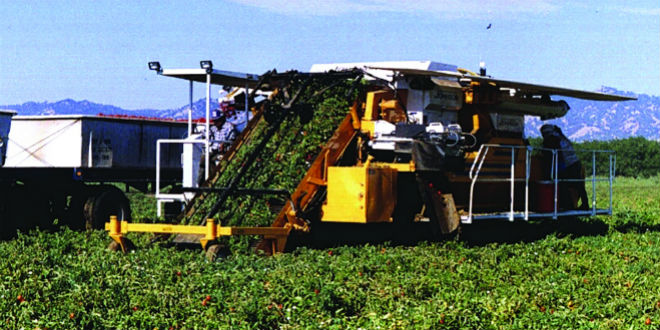May 18, 2016Decades of development lead to mechanization of agriculture


The most common type of seeder is called a planter, which spaces seeds equally in long rows, usually 2 to 3 feet apart. Some crops are planted by drills, which put out much more seed in rows less than a foot apart, blanketing the field with crops. Transplanters automate the task of transplanting seedlings to the field. With the widespread use of plastic mulch, plastic mulch layers, transplanters and seeders lay down long rows of plastic, and plant through them automatically.
After planting, other implements can be used to cultivate weeds from between rows, or to spread fertilizer and pesticides. Hay balers can be used to tightly package grass or alfalfa into a storable form for the winter months.
Modern irrigation relies on machinery. Engines, pumps and other specialized gear provide water quickly and in high volumes to large areas of land. Similar types of equipment can be used to deliver fertilizers
and pesticides.
Besides the tractor, other vehicles have been adapted for use in farming, including trucks, airplanes and helicopters, such as for transporting crops and making equipment mobile, to aerial spraying and livestock
herd management.
Spike in innovation
The trend in innovations in specialty agriculture is just taking off, according to industry watchers.
Frank Tobe, owner and publisher of The Robot Report, which tracks the business of robotics, said the era of robotics in agriculture is upon us.
Tobe cited the following factors driving the technological uptick:
- Major U.S. farming conglomerates are buying foreign land and beginning to farm there, citing lower overall costs.
- China is buying land in Africa and sending skilled workers to supervise those new farms.
- Farmers and ranchers the world over are transitioning to precision agricultural methods, i.e., subdividing their acreage into many sub-plots, in some cases right down to the individual plant/tree/animal, thereby enabling increased productivity and lower overall costs.
- Unmanned aerial vehicles are being used to map, observe, sense and spray.
- Unmanned (or at least autonomous) ground vehicles are providing more precise movements and thereby enabling precision practices.
- The U.S. Bureau of Labor Statistics reports that 2012 median pay for farm workers was $9.09 per hour.
- The bureau reports that there were 749,400 agriculture workers in 2012, down 3 percent from 2011.
- 74 percent – approximate number of crop workers in the U.S. who were born in Mexico or Central America, of which more than half are likely to be undocumented (according to Fortune Magazine).
- Crop dusters have the third highest fatality rate among professions in the United States. Ninety percent of crop spraying in Japan is done using small, unmanned helicopters.
- ResearchMoz, in a 2014 report, projected the agricultural robot market size to grow from $817 million in 2013 to $16.3 billion by 2020.
“A little bit of everything is going on everywhere, but the general trend worldwide is toward precision agriculture supplemented by advanced technologies, including robotics,” Tobe said.
“Modern farmers and ranchers are already high-tech,” Tobe said. “Digitally controlled farm implements are regularly in use. There are partially and fully automatic devices for most aspects of agricultural functions, from grafting to planting, from harvesting to sorting, packaging and boxing.
“Farmers use software systems and aerial survey maps and data to guide their field operations,” Tobe said. “They also use auto-steer systems included in many new tractors (or buy kits that do the same thing), which follow GPS and software guidance. Some farmers are already transitioning some of their operations to full autonomy.
“Thus, forward-thinking farm owners today may be able to skip over slow, incremental improvements and jump directly to robotic and autonomous automation,” Tobe said.
— Gary Pullano, associate editor















